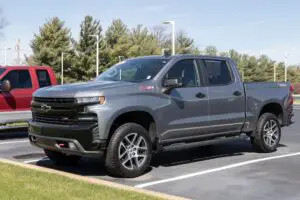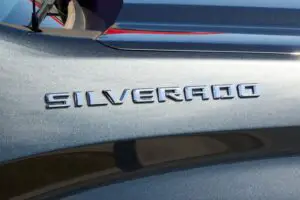The Chevy Silverado is a very reliable vehicle. However, over time, issues might build-up, causing problems in the engine, which might result in your Chevy Silverado not starting.
As there are numerous reasons for the truck not starting, diagnosing the issue can be a problem.
If your truck isn’t starting, and you’re confused and looking for the answer to ‘Why won’t my Chevy Silverado start?’, there are many possible answers.
Therefore, you should rule out and check the most common issues first. Some common reasons your Chevy Silverado might not be starting is because of:
- A Dead Battery
- An Empty Fuel Tank
- Spark Plug Issues
- A Faulty Starter
- Fuel Pump Issues
- Ignition Coil Problems
- Internal Damage
- Compression Issues
This article will discuss each of these issues in detail and address how to solve these issues.
There is also a list of the most frequently asked questions by Silverado owners at the end, so be sure to check it out.
Table of Contents
- 1 What Would Cause A Chevy Silverado To Not Start?
- 2 Frequently Asked Questions
- 2.1 Q1. Why Won’t My Chevy Silverado Start With New Battery?
- 2.2 Q2. Why Won’t My Chevy Silverado Start Even With A Jump?
- 2.3 Q3. Why Won’t My Chevy Silverado Start But Lights Work?
- 2.4 Q4. Why Won’t My Chevy Silverado Start But Cranks?
- 2.5 Q5. Why Won’t My Chevy Silverado Start Just Clicks?
- 2.6 Q6. Why Won’t My Chevy Silverado Start In The Cold Weather?
- 2.7 Q7. Why Won’t My Chevy Silverado Start After I Get Gas?
- 2.8 Q8. Why Won’t My Chevy Silverado Start But Radio Works?
- 3 Conclusion
What Would Cause A Chevy Silverado To Not Start?

Having your Chevy Silverado not starting and not being able to identify why can indeed be frustrating, which is why you have to be informed on what might be causing it and how to solve it.
Let’s look into some of the most common problems.
1: A Dead Battery
Since batteries are charged when you are driving the truck, if you are only driving for small distances or turning the Silverado on and off numerous times or leaving the truck, its lights or the radio on for long periods without driving it, this might drain the battery out, and the truck will not start.
To check if the reason your truck isn’t starting is due to a dead battery, you can check for signs.
One of the signs is when the ignition turns over but does not fire the engine. If, for example, nothing is happening, the battery is completely drained.
However, if the battery has a charge when charging testing but the engine isn’t starting, this might mean that the battery’s connections are corroded.
To test if the battery has a low charge or not you can either use a battery charge tester or do so yourself by turning the interior lights on, if they are dimming quickly, then the charge is low.
What Should You Do About It?
- Jump start the Chevy Silverado and then drive it. Driving it will charge the battery.
- Keeping a jumper cable set in your truck is important in case the battery dies unexpectedly.
- If, however, the issues are corrosion or the malfunctioning of the battery, then you have to get the battery replaced.
- Remember to get the battery’s connectors replaced along with that as well.
2: An Empty Fuel Tank
Usually, you might feel like the Chevy Silverado truck has some serious issue when the problem is forgetting to fill the fuel tank. It is common to forget to fill it up.
In this case, you must check the fuel gauge to check the fuel level. It is also important to ensure you avoid empty fuel tanks as this can cause many problems.
In addition, driving your car on low fuel may also create issues.
The petrol in an empty fuel tank might collect debris that has built up, and if this petrol is pumped through the vehicle, various components can get clogged up, such as the fuel pump and the filter.
What Should You Do About It?
- Get a fuel refill, which will solve the problem in most cases. This will be the case with all Silverados with normal fuel.
- However, if your Silverado is a diesel, you must bleed the fuel system before the vehicle can start again.
3: Spark Plug Issues
Since spark plugs are a very important part of the fuel system, if the Chevy Silverado is cranking but not starting, the problem might be an issue with the spark plug.
Spark plugs deliver electric current to the combustion chamber from the ignition system.
They are supposed to ignite the air mixture and the compressed fuel, which the piston delivers and maintain the combustion pressure.
There are many reasons for faulting the spark plug, which means their lifespan is over. However, some symptoms which appear in the truck can indicate the spark plug issue.
For example, if the vehicle starts consuming more gas, if the acceleration decreases, it becomes hard to start the vehicle, the engine misfires, or there is rough idling.
It depends on your Silverado model, but spark plugs usually have a lifespan of 30,000 to 120,000 miles. (Also, learn how long can your Chevy Silverado last here).
However, the spark plug wires and the ignition coils will last you twice as long as this.
It is not that complicated to replace a spark plug. However, you might have to be getting into intake manifolds and shields.
What Should You Do About It?
- Get a spark plug tester. After this, connect it to your spark plug and place it on the ignition wire. Turn the ignition on and check the tester’s clear sides.
- You will see sparks or a glow if the spark plugs are firing, even if the vehicle is not starting.
- You can also check using your eyes. First, take the spark plug out of the engine. Then place the tester ignition worn on the terminal where you removed the spark plug.
- Use the spark plugs lower metal part to touch it to the cylinder head’s metal part. Then turn your engine over. You might see a spark from the spark plug tip.
- After removing the spark plug, you have to check it to see if you will need to replace it.
- For this, examine the top. The spark plug is fine if the electrode at the center has a grayish or light brown residue.
- Also, there shouldn’t be any black deposits or oil on it, as this might cause the vehicle to have a starting problem. If, however, it is faulty, then you will need to replace it.
- To replace the spark plug, remember to get the new one of the same type as the previous one.
- After replacing, try and start the engine. If the Silverado still cranks but not starting, then the spark plug is not the issue, and you need to look for other issues which might be causing the starting problem.
4: A Faulty Starter
A common cause of stating issues has a broken starter. This can be indicated by a loud clicking noise when you’re trying to start the Chevy Silverado.
If the starter has worn down because of age and usage or material defects, this might hinder performance. First, you have to check if the problem lies in a broken starter or not.
What Should You Do About It?
- You can test if the starter is broken by manually applying 12 volts to the starter with a remote switch.
- The remote switch can be bought at any local store selling auto parts. Using the remote switch will tell you if the starter is faulty or not. In addition, this will also cause the engine to start.
- However, if the starter is broken, this cannot be fixed. This is because it is deep inside the engine block; therefore, it can’t be reached. Because of this, you will have to get the starter replaced.
- To replace the starter, you will have to take it to the garage first, and because the vehicle isn’t starting, you’ll need a lift.
5: Fuel Pump Issues
Even if the fuel tank is full, there might be many reasons the fuel is prevented from reaching the engine.
The symptoms you will see for this issue are the same, which happen when there is a lack of fuel in the tank.
However, this issue will be easier to indicate. If you’re sure about having filled it, you can also check.
If there are issues with the fuel pump or the injection system, this will prevent the fuel from getting to the engine block.
In addition, if the fuel is contaminated, this will also cause the same problems. This is mostly because of improper setting.
What Should You Do About It?
- If the settings are improper, which is causing the problem; you will have to get the setting properly calibrated again. This will solve the issue in most cases.
- If the damage is in the fuel system parts, then you will have to get them replaced.
- Because repairing the different fuel system parts is a complicated task, you will have to take it to the auto shop instead of attempting to do it yourself.
6: Ignition Coil Problems
Most newer models of Chevy Silverados don’t have distributors but, instead, come with specialized self-contained plug wires with their own coil.
You can get this in a coil pack, or it might attach the wire and the plug. If the ignition coil shows a clear spark, then the ignition coil is not the problem.
The problem is probably with the wires connecting the plugs, coil, and distributor.
What Should You Do About It?
- If there is a spark, you’ll have to look for other reasons your Silverado might not be starting.
- However, if there is no spark, you’ll have to look at the problem’s coil or the interrelated wires.
- Check if the ignition coil has the right voltage. If it does not, then check if there are any disconnections or interference.
- You should also check if the crankshaft position sensor is working properly.
7: Internal Damage
There is also a possibility that there are internal damages with your Chevy Silverado. These might occur due to accidents, wearing off due to extended usage, or animals.
Not only this, some animals chew up the internal wires of the engine, which itself can cause many issues, which might lead to the issue of the vehicle not starting.
Moreover, even if you drive the vehicle safely and properly, this can still cause vibrations that might loosen the plug connections. However, these loose connections can easily be fixed.
What Should You Do About It?
- If the issue is loose connections, then you can easily solve this by tightening them down. If there has been no other damage, these will work properly after doing this.
- If the wires are damaged, however, or there is visible damage with one or more parts, then this is a bigger problem that might need professional help.
- As your vehicle will not be starting, you’ll need to tow it to the closest mechanic and get the damaged parts and wires replaced.
- When you first notice these problems, call AAA. They will either replace these themselves or at least help with towing.
8: Compression Issues
If the fuel-air mix is not compressed, then it will not be possible to ignite the spark plugs which is needed to start your engine.
If leaks happen, then combustion will not occur because of a lack of compression, and the vehicle will not start.
These issues usually result from a jumped timing belt, damaged or burned valves, compression rings that are worn out, or a blown head gasket.
Other symptoms might be if you hear tickling noises, if there are revving issues or if you see problems such as too much smoke or other issues with the exhaust. (Get the best exhaust system for your Chevy Silverado).
What Should You Do About It?
- The timing belt or the chain is supposed to make sure that the crankshaft and the camshaft are rotating in rotation.
- Because these timing belts have a certain lifespan, they will wear out over time. In this case, you will have to get the timing belt replaced.
- You cannot always be sure if the timing belt has worn out by only removing the timing cover, as this will not make everything visible.
- It is; therefore, best to check if it is the right time for replacement by checking the owner manual.
Frequently Asked Questions
Q1. Why Won’t My Chevy Silverado Start With New Battery?

After replacing the dead battery with a new battery, your Chevy Silverado might not be starting due to faulty fuses or the ignition switch.
In this case, check your battery and alternator. There is another possibility of forgetting to reconnect the positive cable which goes to the starter.
To confirm this; check between the battery and firewall under the windshield.
Q2. Why Won’t My Chevy Silverado Start Even With A Jump?
The Chevy Silverado should have started with a jump, but if it isn’t, it is probably because of the battery having a short in it, due to which there might not be enough charge to turn the starter over.
You should first get your battery checked and if it is fine, then check the starter.
Q3. Why Won’t My Chevy Silverado Start But Lights Work?
When the Chevy Silverado’s lights are turning on, but it isn’t starting, it means that the battery is charged, but there is a problem with either the starter or the ignition.
To solve this problem, a charged battery can be used to jump the starter engine.
Q4. Why Won’t My Chevy Silverado Start But Cranks?
If the Chevy Silverado is cranking when you turn the key, but the engine isn’t starting, it could be because of the fuel not getting into the engine.
Dirty fuel injectors could be a possible cause, as with time, fuel injector nozzles might clog up with corrosion, rust, or debris.
Q5. Why Won’t My Chevy Silverado Start Just Clicks?
If your Chevy Silverado is clicking but not starting, the problem might lie in a dead battery or the alternator charging your battery.
If the reason for the clicking is electrical, it means that the starter is out of juice to stay powered. The starter is a small motor energized by the engine’s battery.
Q6. Why Won’t My Chevy Silverado Start In The Cold Weather?
When the temperature is cold, this can affect the battery’s chemical process. This might reduce the ability of the battery to hold a charge.
A cold temperature can also thicken the oil or increase friction inside the starter motor, which will force the starter motor to work harder.
Q7. Why Won’t My Chevy Silverado Start After I Get Gas?
The most likely reason for your Chevy Silverado not starting after a gas refill is when the EVAP purge control valve is stuck open.
Because of this, your intake manifold will get fuel pushed inside of it. There are other reasons, for example, a dead battery, a clogged filter fuel, or if the fuel pump is bad.
Q8. Why Won’t My Chevy Silverado Start But Radio Works?
If the radio and the lights (possibly) are working, but the Chevy Silverado is not starting, this could be because of a bad battery, which you should get replaced.
The battery is producing enough current to power the radio and electrical components; however, it is not enough to start the truck.
Related: What Are The Worst Years For The Chevy Silverado?
Conclusion
I hope you’ve found the answer to “Why won’t my Chevy Silverado start?” in this article. There are many issues with the engine which might cause your truck to not start.
Among these, the most common are battery issues or fuel tank issues.
However, other ones are also possible. It is, therefore, best to work step by step and eliminate the most common reasons first.
However, you will not always be able to solve the issue yourself, especially if there is a serious problem, for example, internal damage, when you’ll have to visit a mechanic.

I am Tahir Azam, and I have been writing amazing articles for TaxiHack for as long as I can remember. I know everything that is to know when it comes to automobiles and is always on top of industry news and developments. While I am not an expert by any means, I pride myself on knowing the ins and outs of many different problems and, of course, their solutions. The articles on our website are some of the best and well-researched content that you will find, and I spend countless hours making sure this remains to be true. This is why I ask you to take your time out and read some of my articles, especially if you find a topic that resonates with you or is something you are looking into. This way, you will find the perfect mix of information and tips on your desired topic. Learn more about Tahir.


![Chevy Silverado: Model Years To Avoid [And Safely To Buy] Knowing the best year to buy a Chevy Silverado 1500 to avoid future problems](https://taxihack.com/wp-content/uploads/2021/07/worst-years-for-chevy-silverado-300x200.jpg)
![How Long Is A Chevy Silverado? [Bed & Cab Length Sizes] Knowing the length of a Silverado can give you an idea of what purpose for you to drive that truck](https://taxihack.com/wp-content/uploads/2021/07/silverado-length-300x200.jpg)